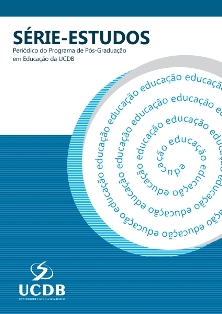Mastering language use and usage: repositions perceived according to cognitive linguistics
DOI:
https://doi.org/10.20435/serie-estudos.v22i46.1087Palavras-chave:
prepositions, cognitive linguistic, English Language.Resumo
Mastering prepositions has often been difficult for English language learners as a consequence of their polysemous nature and the sheer number of them in the English language. Most of the evaluations of the scientific output of the English language learners have established that prepositional addition, omission, and substitution account for most of the syntactic errors. For this reason, it is important for tutors to come up with effective instructional methods, since prepositions present such an immense challenge for the English language learners. Teaching prepositions are difficult due to various reasons. The present article has as objective the approach on the application of Prepositions and how structure and meaning may be perceived according to cognitive linguistics, based on other articles / books that served as bibliographical research for the construction of some ideas.Referências
AARTS, B. Grammar. In: BROWN, K. (Ed.) Encyclopedia of language & linguistics. 2. ed. Estados Unidos: Elsevier Science, 2006.
ACHARD, M. Teaching construal: cognitive pedagogical grammar handbook of cognitive linguistics and second language acquisition. New York: Routdledge, 2008.
EVANS, V.; BERGEN, B. K.; ZINKEN, J. (Ed.). The cognitive linguistics reader. London: Equinox, 2007.
DANCYGIER, B.; SWEETSER, A. Figurative language. Cambridge: Cambridge University Press, 2014.
FOSS, K. A.; FOSS, S. K.; TRAPP, R. Readings in contemporary rhetoric. New York: Waveland Press, 2002.
GEERAERTS, D. Cognitive linguistic. New York: Mouton de Gruyter, 2006.
LAKOFF, G.; JOHNSON, M. Metaphors we live by. Chicago: University of Chicago Press, 2003.
LIU, D. Describing and explaining grammar and vocabulary in ELT: key theories and effective practices. New York: Routledge, Taylor & Francis Group, 2014.
MAHAPATRA, B. C. Models of teaching in education: with special preference to researches in synatics and gaming models of teaching. New Delhi: Sarup & Sons, 2004.
PAYNE, T. E. Undestanding English Grammar - a linguistic introduction. New York: Cambridge University Press, 2011.
TYLER, A.; EVANS, V. The semantics of english prepositions: spatial scenes, embodied meaning and cognition. New York: Cambridge University Press, 2003.
Downloads
Publicado
Como Citar
Edição
Seção
Licença
A revista Série-Estudos permite a reprodução total em outro órgão de publicação mediante a autorização por escrito do editor, desde que seja feita citação da fonte (Série-Estudos) e remetido um exemplar da reprodução. A reprodução parcial, superior a 500 palavras, tabelas e figuras deverá ter permissão formal de seus autores.
Direitos Autorais para artigos publicados nesta revista são do autor, com direitos de primeira publicação para a revista. Em virtude de aparecerem nesta revista de acesso público, os artigos são de uso gratuito, com atribuições próprias, em aplicações educacionais e não-comerciais.

